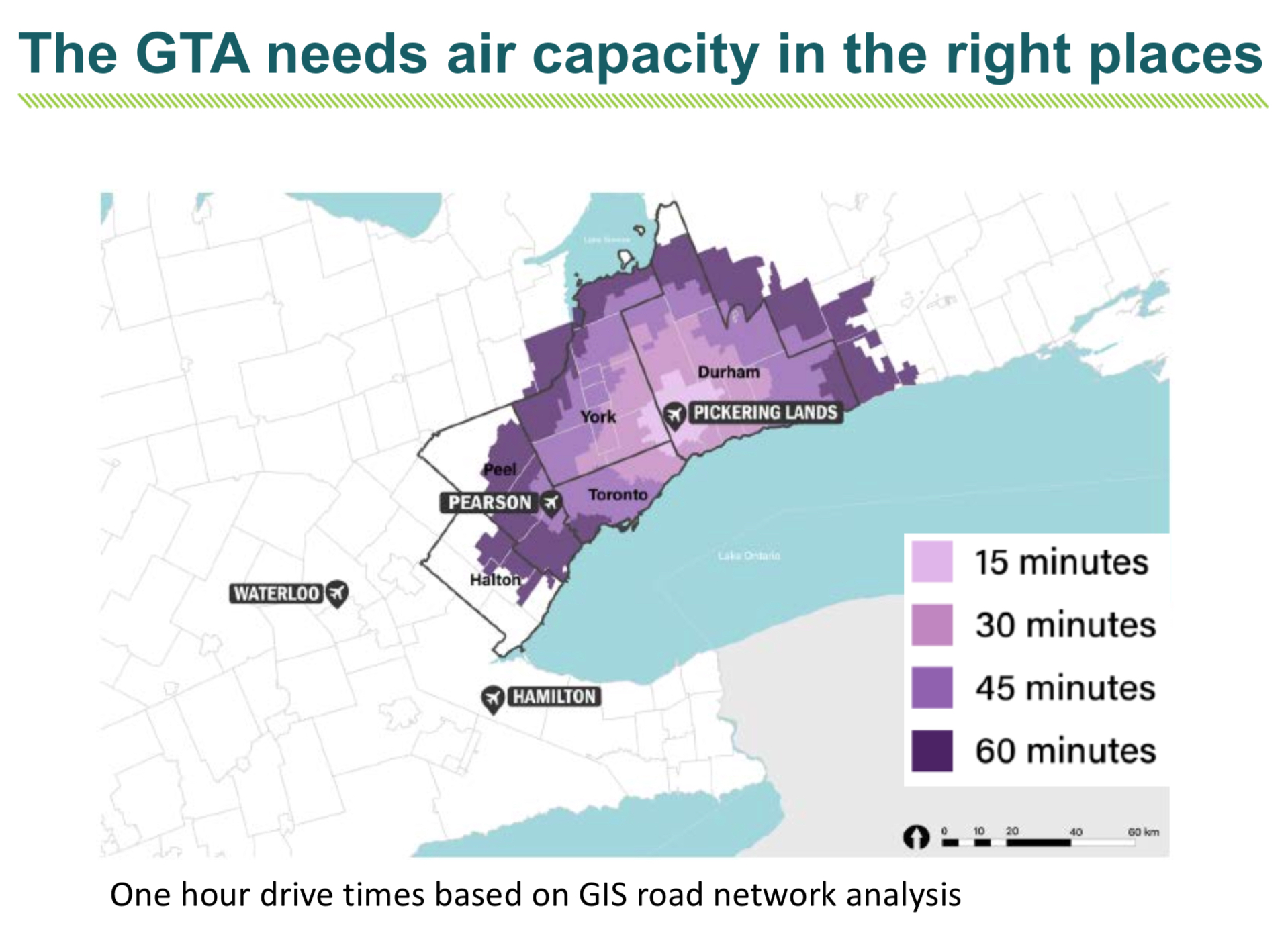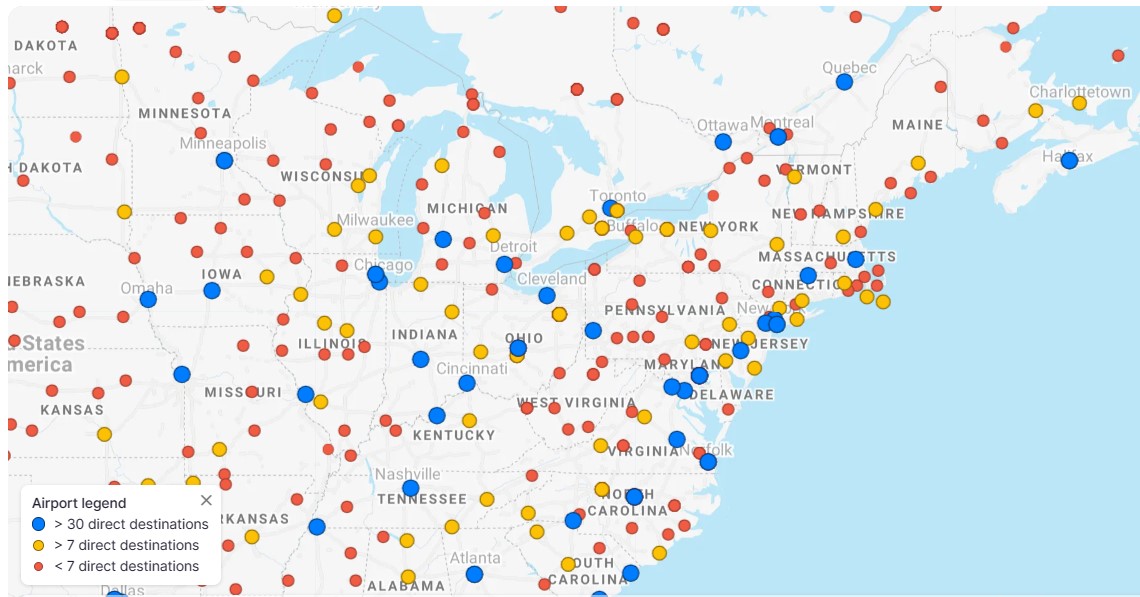The Pickering Airport Advantage- Location, Location, Location!
Airlines are in the business of operating routes between cities. Airports are the gateways between these cities. Profit and customer satisfaction are an airline’s goals. Airlines around the world are constantly looking to add profitable new destinations to their route networks to satisfy customer demand. Both the demand for air travel and the population of the Eastern Toronto region is growing. Pickering Airport will be at the top of the list of new route candidates when it opens for three reasons. Location, Location and Location!
Pickering airports value to an airline is derived from its location in relation to potential customers and to existing airports. For years, Toronto Pearson Airport has been the main passenger airport for the Greater Toronto Area (GTA) due to its location in relation to population. But that population is growing eastward away from Pearson.

Today, within a 30 kilometers radius of the new Pickering Airport is a population of 2.5 million people. This eastward growth is creating a dead zone for local accessible aviation services for an increasing part of the GTAs population. A population that is expected to grow by 40% over the next several decades according to the Ontario provincial government. This lack of service creates additional congestion on highways as passenger, employees and cargo travel for hours enroute to/from Pearson airport.
The new Pickering airport itself is sitting next to Highway 407 making it easily accessible to passengers and cargo logistics. In addition to the airport, the Government of Canada owned Pickering lands will host a 30 million sq ft industrial park as well as new greenhouse and vertical farming. It will operate as a logistics and net zero emissions energy hub, the center of a new AEZ (Airport Employment Zone). Today Toronto Pearson airport is one of the most congested (airside and roadside) and most expensive airports in North America.
While high landing fees for smaller aircraft is a time honoured way of discouraging smaller airlines from utilizing congested airports, Pearson is setting records in Canada. Landing a small commuter airline at Pearson can add up to $100 per ticket. Regulated under Canadian Aviation Regulations (CARs) section 703/704, Commuter operations, sometimes called Air Taxi, are small regional aircraft with up to 19 seats. Smaller commuter airlines are expected to be some of the first users of Pickering Airport.
Pearson consistently ranks near the bottom for on time performance thanks to congestion and has no room to grow. Pearson uses a slot allotment system that restricts when an aircraft can arrive and depart. These restrictions plus the high costs of operation create a contentious block stopping new routes by airlines not already established at Pearson. This is especially true for those flying smaller regional aircraft.

For airlines looking to sidestep Pearson Airports challenges, Pickering Airport’s location, lower cost of operation, lack of congestion and on time reliability will be very attractive. Smaller commuter airlines utilizing aircraft like the Pilatus will be encouraged at Pickering Airport.
Pickering is expected to be the go-to location for new smaller aircraft and airline routes being squeezed out of Pearson Airport.
As you would expect airlines perform multiple evaluations using a number of different tools in order to know if a route will be profitable in the long term. They look at passenger demand forecasts, land transportation connectivity, aircraft availability, and watch their competitors closely.
The considerations any airline must make when evaluating a new or existing route are complex. Ultimately it is the consumer that decides.
What is the value add for a Passenger?
For a passenger living within Pickering’s passenger catchment area the new airport will have a lot to offer compared to Pearson and other distant airports. This includes a shorter drive or taxi ride, strong transit connections, cheaper parking, faster security lines and cheaper ticket prices at peak travel times.
When an airline fly’s multiple times a day between two cities from uncongested airports without slot restrictions, they can offer flights evenly spread out during the day. Business travelers usually enjoy taking a flight in the morning and return home at the end of the day after their work is done. Passengers prefer direct flights over the uncertainty of making a connection.
With these advantages in mind, Pickering and Pearson airports are expected to play different, complementary roles to each other. To understand more about what these are, as well as a look at potential routes from Pickering stay tuned for Part 2 of Pickering Airport Passenger Routes, “Airline Considerations for New Routes”.
Find out why the exciting destinations listed below and more will soon enhance your world with the freedom of flight!

Related Posts:
e-Regional airlines and Pickering Airport – Friends of Pickering Airport
References:
Ontario population projections | ontario.ca
Canadian Aviation Regulations (justice.gc.ca)
FlightConnections – All flights worldwide on a map!
Which U.S. Cities Are Major Hubs and Why it Matters (airfarewatchdog.com)
Delete “Pickering” read Oshawa ..all else is the same.
Not really. Oshawa airport is too small with no room to grow, and surrounded on 3 sides, by residential homes – not great for jets landing and taking off. No economic zone planned or existing around it.
your article makes great valid points, but begs the question where are the airlines, courier companies, airport building and management contractors, unions and other stakeholders? Why aren’t they at the table making the case for this airport, every time there is a public meeting about it?
Thank you for your comment and support. The answer to your question is that when investors try to get to the table, they find the door to the conference room is locked. The federal cabinet has the key and decides who sits at the table and when the meeting should start. That is apparently mid 2025 after the release of the final study.
A good case in point is the CEO of Hitachi Howard shear who out of frustration came to the February 27th Pickering council Meeting with a billion dollars to invest in his hands. The council listened politely but had nothing to say to him except go away. All of the noise and motions about opposing the airport is meant to scare away investors just like Howard. He didn’t need to be told twice as there are lots of other communities begging for the high-tech investment he is offering. Others have gone before him including Amadale, who wanted to move Buttonville airport to Pickering, De Havilland Canada that ended up building a private airfield near Calgary and Mitsubishi heavy industries.
But despite the noise from local council, It is up to the feds to unlock the door and invite the investors in. So far, they have declined from doing so although the new study is preparing the way.